|
Q: I saw scissors. Were you trimming your brush?
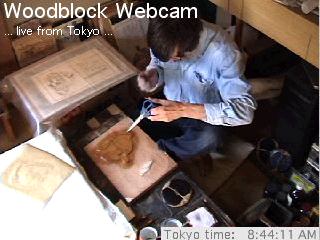
A: Yes, I'm just doing a quick
trim on the brush - a number of hairs started to
pull out from the 'pack' and leave streaks in the
pigment. You can't just pull them,
or they will soon be followed by a lot more ...
Q: A couple of times this morning, you seemed to be making
adjustments to the register marks ...
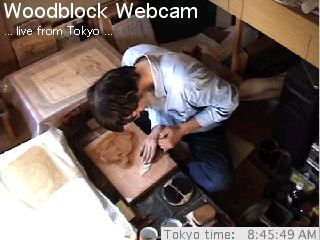
A: The print I was working on this
morning is a reprint of one of the poets in my Hyakunin
Isshu series. This particular set of blocks was carved
around a half-dozen years ago, and is now being reprinted
for the first time since then.
In the intervening years, the wood has dried out
a bit more, and some of the registration marks now no
longer match up. Sometimes, when there has been major
shrinkage, this is a huge problem, but this morning, a
slight trim of one of the marks was enough to pull the
registration back into line ...
Q: I see you are using something to protect the
paper from the baren. I thought you told us that this
shouldn't be necessary?
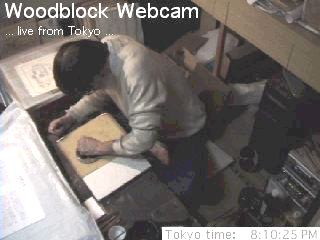
A: Hey, let's keep the questions above the
belt, or I'll have to shut this thing down! :-)
Well, I'll stand by what I said - use of a
protective backing sheet like this shouldn't be necessary ...
if the baren skin is in good condition, and if it
is properly lubricated, if the sizing in the paper
was applied correctly, and ... if the printer has a good
'touch'. In the case of this evening's printing,
it's the sizing that is giving me trouble. The paper
is extremely soft, and the rear surface is abrading a bit, no matter
how carefully I try and control the other points ... But were you still watching some time later?
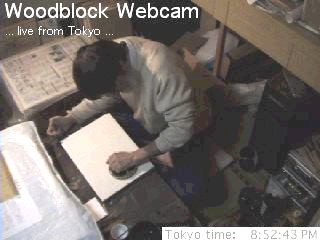
I managed to find that 'touch', and did the balance of the
print run without the backing sheet. Maybe one day I'll be able
to find it right from the first sheet ... every time!
Q: What is in that little plastic bottle?
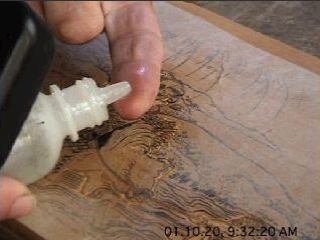
A: It's camellia oil - the same
stuff that printers use to lubricate the
undersurface of the baren. Carvers use it too
...
In this case, I'm just about to smear a
little dab of it over the surface of the
hanshita (the tracing that is pasted onto
the wood) to make it transparent. Although I
previously peeled away much of the back of the
paper, it's still a bit unclear in a couple of
places. This oil makes it practically invisible.
Q: Who is the guest we saw in your workroom this evening,
'helping' you with your carving?
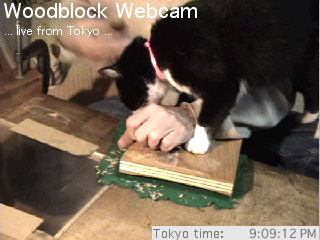
A: Meet 'Boots' ... She doesn't live here, but
in the house next but one, although you wouldn't know it from the
amount of time she spends here. She's a bit unusual for a cat in that
she doesn't like to be by herself. And as they are away at work/school
all day, and I'm here all the time ... this is the result ...
Q: What were those little triangular blocks of wood?

A: The 'block' I'm using in that photo isn't
a 'block' at all, but is just some pieces of wood cobbled together
as a jig to hold some metal type for embossing my name on the print.
The type is held facing up, and I 'print' the paper normally
with a baren. The triangles you see are just scrap pieces to hold
the paper basically level in place in the proper position ...
Q: It looks like you are using some sort of protective sheet? Is it mylar ?
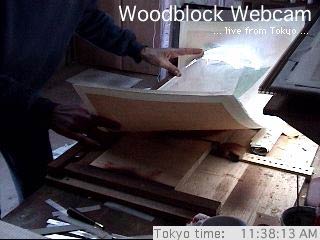
A: I am using two different sheets of mylar to help me make this impression. The paper is very large, and of course damp, so it is very difficult to handle. Each time I take a sheet out of the damp-box, I carry it together with a sheet of quick thick mylar. This gives me enough control to get it moved to its proper place on the block.
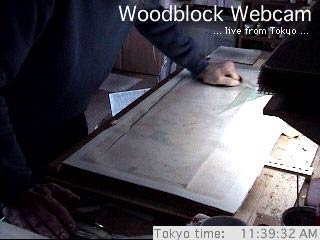 A: Then, once it is in place, I remove the heavy mylar, and use a sheet of extremely thin mylar as a protective backing to avoid damage from the baren. For the impression today, I am using a ball-bearing baren, and this cannot be used without such a sheet. (This paper is very thick, and the powerful bearing baren is a great help ...)
A: Then, once it is in place, I remove the heavy mylar, and use a sheet of extremely thin mylar as a protective backing to avoid damage from the baren. For the impression today, I am using a ball-bearing baren, and this cannot be used without such a sheet. (This paper is very thick, and the powerful bearing baren is a great help ...)
|

